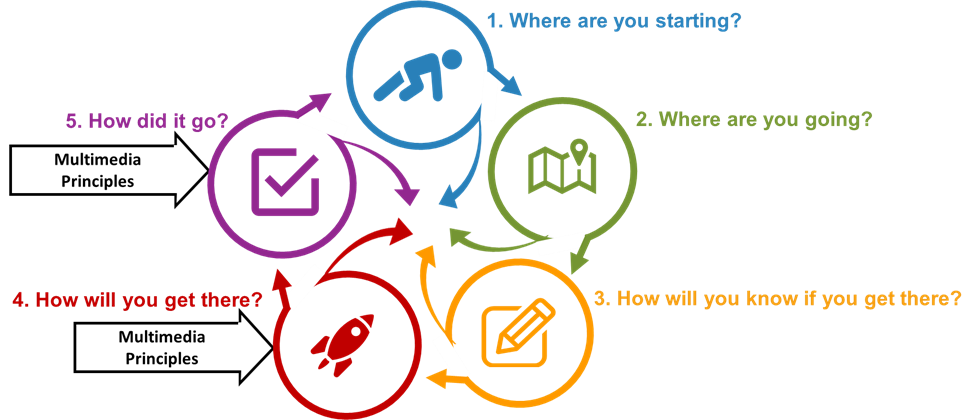
B. Learning & Instructional Design Principles
B6. Multimedia Principles
Multimedia Principles
Often, as instructors we provide materials to students as a series of words (lectures and books, for example). These types of presentations provide students with limited visual cues. According to Mayer, the cognitive theory of multimedia proposes three main assumptions when it comes to learning (Cognitive Theory of Multimedia Learning, n.d.):
- There are two separate channels (auditory and visual) for processing information (sometimes referred to as Dual-Coding theory);
- Each channel has a limited (finite) capacity (similar to Sweller’s notion of Cognitive Load);
- Learning is an active process of filtering, selecting, organizing, and integrating information based upon prior knowledge.
However, material uses just one channel. According to R. C. Clark & Mayer (2011, p. 3.2) “Multimedia presentations can encourage learners to engage in active learning by mentally representing the material in words and in pictures and by mentally making connections between the pictorial and verbal representations.” Mayer defines multimedia as a picture, graphic, video, or other visual aid (“Principles for Multimedia Learning with Richard E. Mayer,” 2014).
Mayer’s research has provided a series of 12 principles for designing multimedia (Table). By applying these principles, instructors can design multimedia presentations, handouts, webpages, etc. to minimize students’ cognitive load and support learning.
For a checklist to help you check your multimedia (presentations including chalkboard writing, PowerPoint slides, webpages, and transparencies, etc.) see Worksheet 4.1i – Cognitive Load Checklist. For further descriptions of these, see “Principles for Multimedia Learning with Richard E. Mayer,” (2014) or Mayer (2005).
Table: 12 Principles for Designing Multimedia from Mayer (2005)
| Reduce Extraneous Processing |
| Coherence Principle – People learn more deeply from a multimedia message when extraneous material is excluded rather than included. Signaling Principle – People learn more deeply from a multimedia message when cues are added that highlight the organization of the essential material. Redundancy Principle – People learn better from graphics and narration than from graphics, narration, and on-screen text. Spatial Contiguity Principle – People learn more deeply from a multimedia message when corresponding printed words and graphics are presented near rather than far from each other on the page or screen. Temporal Contiguity Principle – People learn more deeply from a multimedia message when corresponding graphics and narration are presented simultaneously rather than successively. |
| Manage Essential Processing |
| Segmenting Principle – People learn more deeply when a multimedia message is presented in user-paced segments rather than as a continuous unit. Pre-training Principle – People learn more deeply from a multimedia message when they have learned the names and characteristics of the main concepts. Modality Principle – People learn more deeply from graphics and narrations than from animation and on-screen text. |
| Foster Generative Processing |
| Personalization Principle – People learn more deeply from a multimedia message when words are in conversational style rather than formal style. Voice Principle – People learn more deeply when the narration in a multimedia message is spoken in a friendly human voice rather than a machine voice. Embodiment Principle – People learn more deeply when onscreen agents display human-like gesturing, movement, eye contact, and facial expression. Image Principle – People do not necessarily learn better from a multimedia lesson when the speaker’s image is added to the screen. |
IDI & Multimedia Principles

The following describe actions you can take to use concepts from multimedia principles in the IDI model:
Step 4. How Will You Get There?
4.1 Develop & Teach Course
- Apply all multimedia principles when developing webpages, materials for the LMS, slides, and handouts.
Step 5. How Did It Go?
5.1 Evaluate Course Success
- Use the class outline to note how various activities worked.
References
Clark, R. C., & Mayer, R. E. (2011). E-learning and the science of instruction: Proven guidelines for consumers and designers of multimedia learning (3rd;Fourth;). Pfeiffer.
Cognitive Theory of Multimedia Learning. (n.d.). Online@JSU. Retrieved August 15, 2022, from https://www.jsu.edu/online/faculty/cognitive-theory-of-multimedia-learning.html.
Mayer, R. (2005). Cognitive Theory of Multimedia Learning. In R. Mayer (Ed.), The Cambridge Handbook of Multimedia Learning (pp. 31–48). Cambridge University Press. https://doi.org/10.1017/CBO9780511816819.004.
Principles for multimedia learning with Richard E. Mayer. (2014, July 8). Harvard Initiative for Learning & Teaching. https://hwpi.harvard.edu/hilt/blog/principles-multimedia-learning-richard-e-mayer
